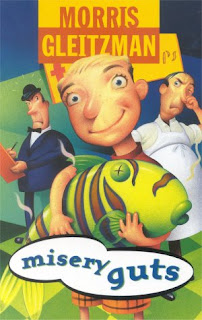I have read two novels since I last wrote. The first is the final installation in the Harry Potter series called The Deathly Hallows and the other is called Misery Guts by Morris Gleitzman. I have also read six picture books. These being the Ugly Duckling, Glub the Baby Dinosaur, A Sea Full of Sharks, Creatures of the Great Barrier Reef, Dinosaurs and Dr. Suess's ABC.
As mentioned above this book is the final one in the Harry Potter Series and in my opinion the best. It is action filled with twists around every corner that keep the reader always interested. By far the best part of the book is the fight between Harry and Lord Voldemort at the end in the Great Hall. In this part Rowling has used amazing descriptions to keep the reader entertained. The book is written from a first person view coming from the main character Harry. By doing this the reader really relates to the main character and can familiarize themselves with him.
Misery Guts is a book by Morris Gleitzman that follows the life of a young boy who is constantly trying to make his unhappy parents happy. The only problem is he fails miserably. After various attempts to make his parents happy he finally convinces them that they will be happy if they move to Australia. But does it work?
This book is great for children because there is good use of describing words but no real descriptions of any characters to the reader has to use their imagination to decide what the characters look like. The style of writing used is also very sarcastic and informal.
The Ugly Ducking is a classic story that tells about the life of a young duck who is excluded from the group because he looks different. Only to discover later in the book that he is not a ugly duck, but rather a beautiful swam. This is a very good book and children who are of younger ages will always enjoy reading this. The writing is very simplistic so that the reader can understand what is going on easy and the pictures are will illustrated to keep children interested.
Glub the Baby Dinosaur is the story of a caveman who accidentally kicks an egg thinking its a rock. But after the egg starts to act strangely realizes it is an egg not a rock. At first Glub lives in the gave but he gets to big and Trevor the caveman has to go out and look for Glubs Mum. After a while they fall down a ravine and into some slush which they get stuck in, but what will happen next? This story is rather entertaining and kept me interested through the whole thing. A part of the book which interested me was that they put every dinosaur name in bold and them at the back had a section on how to pronounce the names. I found this helpful as some of the names were very hard to pronounce.
A Sea Full of Sharks is a picture book but also a non-fiction book that tells the reader about different sharks. There are over 350 different kinds of sharks of many shapes and various sizes. This book includes up to date information about sharks and offers a new way of thinking about thanks in their natural environment. In the book it gives diagrams of a shark, shark eggs and shark teeth. The book will be good for children in year 4-6 who are interested in sharks as it gives them good information about different sharks that is easy to read and very understandable.
I couldn't source a picture of the Creatures of the Great Barrier Reef because every time I searched for it I got random pictures of sea creatures. In this book there is a small description of the animal and then it asked the question of who am I? then there is a fold out section where you open it up and there is a picture of the animal their with a small description and a few facts about the creature. This book is particularly interesting because not only does it have the animals everyone knows like sharks but it also has animals like puffer fish and mantra rays which students wouldn't know that much about. This is a very interesting book and children in primary school will thoroughly enjoy it.
This book is a pop up book that on each page a picture of a different dinosaur appears and has a short description of under it. In the description it tells us what period they were from, what they looked like and a short paragraph about the dinosaur. This book would be good for students of all ages because in the younger years the teacher can read them to book and the student would be interested by the pictures. However, in the older years the students can read the book for themselves and them enjoy the pictures as well.
ABC by Dr. Seuss is a very interesting book. On each double page is a different letter of the alphabet with words that start with that letter. The first page says big A little a what begins with A? and so on for the next letter. For some of the letters there are just words that start with the letter but on some pages there are tongue twisters. One of the more interesting tongue twisters in the book that I found was Willy Waterloo washes Warren Wiggins who is washing Waldo Woo. When reading this book children of young ages will find you messing words up funny but you can also give the students an opportunity to read the pages themselves and see if they can say the tongue twisters.

















